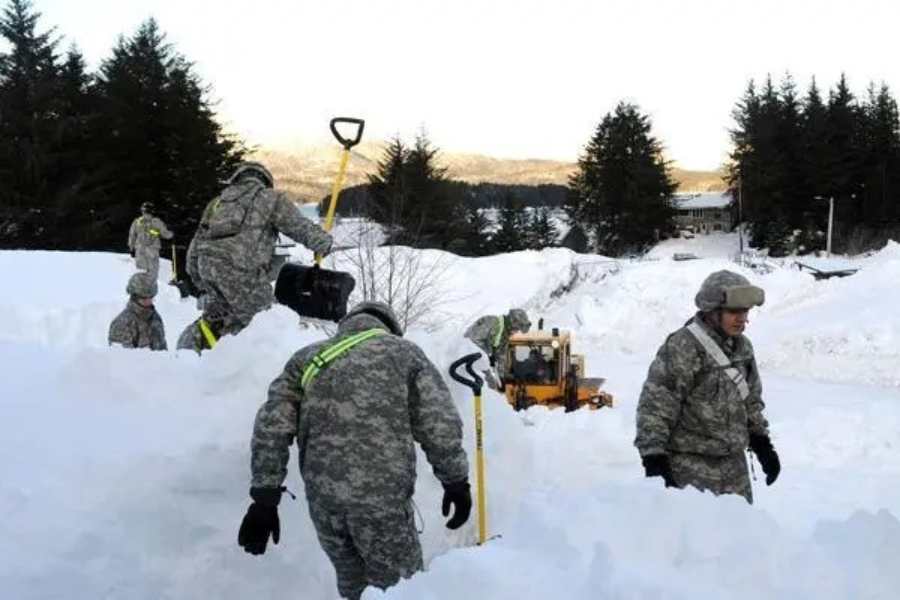
Nestled within Colorado’s breathtaking yet formidable mountain ranges, Breckenridge stands as a vibrant testament to human resilience in the face of nature’s whims.
However, the tranquility of this winter paradise was recently shattered by a harrowing incident. A roof avalanche, swift and merciless, descended upon two unsuspecting teenagers engaged in the innocence of play beneath the seemingly benign expanse of a snow-covered roof.
This calamity not only inflicted critical injuries on one young soul but also served as a stark beacon, illuminating the perilous intersection of natural beauty and potential disaster.
The incident in Breckenridge has catapulted the phenomenon of roof avalanches from a seldom-considered hazard to a forefront concern, pressing upon the conscience of every resident and visitor in snow-afflicted regions.
The reality that such a serene setting can, within moments, transform into a scene of distress underscores the imperative for heightened vigilance. It beckons a community-wide mobilization towards understanding the precursors of such events, fostering an environment where proactive measures—such as regular monitoring of snow accumulation and structural assessments of buildings—are not just recommended but ingrained practices.
This tragic episode is a call to arms for all those dwelling in the shadow of majestic peaks to unite in safeguarding against the silent threats posed by the very landscapes they cherish.
The Incident, A Wake-Up Call: On a seemingly ordinary day in Breckenridge, a town nestled about 80 miles west of Denver at the base of the Rocky Mountains’ Tenmile Range, two youths became unwitting victims of a phenomenon known as a roof avalanche.
As they played outside a home, tons of snow, accumulated atop the roof, dislodged, and descended upon them with little warning, engulfing them in a frigid embrace. The aftermath left one teenager with severe injuries, highlighting the unpredictability and danger posed by such events.
This incident is not merely a local news story but a critical wake-up call for communities across regions where snow and human habitation intersect. Ethan Greene, the Director of the Colorado Avalanche Information Center (CAIC), expressed his concern, stating, “Roof avalanches are a perennial problem in mountain communities, exacerbated this year by significant snowfall in unusual areas.
Such tragic accidents underscore the importance of vigilance and preparedness in mitigating the hazards they present.”
Roof avalanches occur when accumulated snow on a building’s roof suddenly slides off. This can happen after a heavy snowfall, followed by rapid warming, which makes the snowpack unstable. While picturesque snow-capped roofs are a hallmark of winter in mountainous regions, they bear the potential for disaster, as evidenced by the Breckenridge incident and others like it.
Historically, roof avalanches have not only caused injuries but have claimed lives. In Colorado alone, roof avalanches have resulted in five fatalities over the past three decades, with countless others narrowly escaping harm.
The tragedy near Durango in March 2023, where a father and his two children were buried by a roof avalanche, with one child succumbing to injuries, is a stark reminder of the deadly potential of these natural phenomena.
In response to the recent tragedy, the CAIC has issued guidelines to prevent future incidents. These recommendations include monitoring snow accumulation on roofs, avoiding activities near snow-laden roofs, and keeping rescue tools like shovels accessible. Perhaps the most effective measure is the preemptive removal of snow from roofs, which can significantly reduce the risk of avalanches.
However, beyond immediate safety measures, there is a pressing need for broader initiatives to raise awareness about the risks of roof avalanches. This includes education on how to properly assess the stability of snow on roofs and the importance of architectural considerations in snow-prone areas, such as the design of buildings to minimize snow accumulation.
Community and Resilience: Moving Forward
The Breckenridge incident has galvanized community action, with residents coming together to support the affected families and share information on preventing similar tragedies. This collective response underscores the resilience and solidarity of mountain communities, which are no strangers to the challenges posed by their environment
Moreover, this event serves as a poignant reminder of the broader implications of climate change, which can exacerbate the frequency and severity of roof avalanches. As such, discussions around roof avalanche safety are inseparable from the larger conversation about sustainable living and environmental stewardship in vulnerable regions.
The roof avalanche in Breckenridge is a tragic testament to the dangers that lie in wait above our heads during the winter months. It is a call to action for individuals, communities, and policymakers to prioritize safety and preparedness to avert future tragedies. By fostering a culture of awareness, adopting proactive measures, and embracing community resilience, we can navigate the beautiful yet hazardous terrain of our winter landscapes more safely.
As we move forward, let the lessons learned from Breckenridge guide our efforts to safeguard our communities against the silent danger of roof avalanches. It is through vigilance, education, and collective action that we can turn the tide against this hidden hazard, ensuring that the serene beauty of snow-clad regions remains a source of joy rather than tragedy.





